IP for Silterra
-
General Purpose All Digital Fractional-N PLL in GlobalFoundries 22FDX
- Low jitter, suitable for many clocking applications
- Extremely small die area (< 0.01 sq mm), using a ring oscillator
- Output frequency can be from 1 to 400 times the input reference, up to 2GHz
- Reference clock from 5MHz to 500MHz
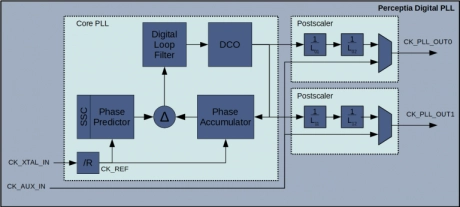
-
LVDS Deserializer IP
- The MXL-DS-LVDS is a high performance 4-channel LVDS Deserializer implemented using digital CMOS technology.
- Both the serial and parallel data are organized into four channels. The parallel data can be 7 or 10 bits wide per channel. The input clock is 25MHz to 165MHz. The De-serializer is highly integrated and requires no external components.

-
LVDS Serializer IP
- The MXL-SR-LVDS is a high performance 4-channel LVDS Serializer implemented using digital CMOS technology. Both the serial and parallel data are organized into four channels.
- The parallel data width is programmable, and the input clock is 25MHz to 165MHz. The Serializer is highly integrated and requires no external components.
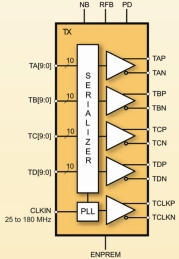
-
I2C Controller IP – Master, Parameterized FIFO, AXI Bus
- The DB-I2C-M-AXI Controller IP Core interfaces an ARM, MIPS, PowerPC, ARC or other high performance microprocessor via the AMBA 2.0 AXI System Interconnect Fabric to an I2C Bus. The I2C is a two-wire bidirectional interface standard (SCL is Clock, SDA is Data) for transfer of bytes of information between two or more compliant I2C devices, typically with a microprocessor behind the master controller and one or more slave devices.
- The DB-I2C-M-AXI is a Master I2C Controller that controls the Transmit or Receive of data to or from slave I2C devices. Figure 1 depicts the system view of the DB-I2C-M AXI Controller IP Core embedded within an integrated circuit device.
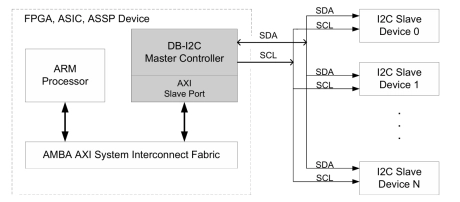
-
I2C Controller IP- Master / Slave, Parameterized FIFO, AHB Bus
-
The DB-I2C-MS-AHB Controller IP Core interfaces a microprocessor via the AMBA AHB Bus to an I2C Bus in Standard-Mode (100 Kbit/s) / Fast-Mode (400 Kbit/s) / Fast-Mode Plus (1 Mbit/s) / Hs-Mode (3.4+ Mb/s) / Ultra Fast-Mode (5 mbit/s).
The I2C is a two-wire bidirectional interface standard (SCL is Clock, SDA is Data) for transfer of bytes of information between two or more compliant I2C devices, typically with a microprocessor behind the master controller and one or more slave devices.
The DB-I2C-MS-AHB is a Master / Slave I2C Controller that in Master Mode controls the Transmit or Receive of data to or from slave I2C devices while in Slave Mode allows an external I2C Master device to control the Transmit or Receive of data.

-
-
I2C Controller IP- Master / Slave, Parameterized FIFO, APB Bus
-
The Digital Blocks DB-I2C-MS-APB Controller IP Core interfaces a microprocessor via the AMBA APB Bus to an I2C Bus in Standard-Mode (100 Kbit/s) / Fast-Mode (400 Kbit/s) / Fast-Mode Plus (1 Mbit/s) / Hs-Mode (3.4+ Mb/s) / Ultra Fast-Mode (5 mbit/s).
The I2C is a two-wire bidirectional interface standard (SCL is Clock, SDA is Data) for transfer of bytes of information between two or more compliant I2C devices, typically with a microprocessor behind the master controller and one or more slave devices.
The DB-I2C-MS-APB is a Master/Slave I2C Controller that in Master Mode controls the Transmit or Receive of data to or from slave I2C devices while in Slave Mode allows an external I2C Master device to control the Transmit or Receive of data.
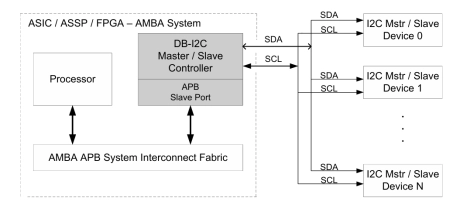
-
-
I2C Controller IP- Master / Slave, Parameterized FIFO, AXI Bus
- The DB-I2C-MS-AXI Controller IP Core interfaces a microprocessor via the AMBA AXI Bus to an I2C Bus in Standard-Mode (100 Kbit/s) / Fast-Mode (400 Kbit/s) / Fast-Mode Plus (1 Mbit/s) / Hs-Mode (3.4+ Mb/s) / Ultra Fast-Mode (5 mbit/s).
- The I2C is a two-wire bidirectional interface standard (SCL is Clock, SDA is Data) for transfer of bytes of information between two or more compliant I2C devices, typically with a microprocessor behind the master controller and one or more slave devices.
- The DB-I2C-MS-AXI is a Master / Slave I2C Controller that in Master Mode controls the Transmit or Receive of data to or from slave I2C devices while in Slave Mode allows an external I2C Master device to control the Transmit or Receive of data.

-
eFPGA Soft IP
- These eFPGA IP cores offer designers the flexibility to tailor resources to their application requirements, available as either Soft RTL or Hard GDSII IP.
- Our standard-cell-based approach facilitates rapid porting to new process geometries or variants, including industrial and rad-hard grade versions.

-
400kHz Touch Sensor - Silterra 0.18 um
- Capacitive sensing oscillator
- 2pF sensibility
- 400kHz output frequency
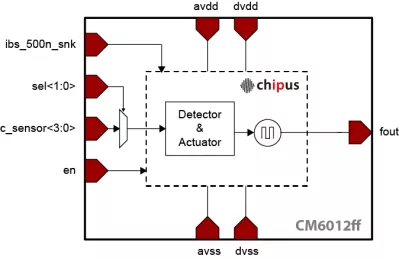
-
General Purpose Temperature Sensor - 2°C accuracy – 10-bit Digital Readout - Globalfoundries 22nm FD-SOI
- CM6217co is a low-power general purpose Temperature Sensor IP featuring 12-bit parallel digital readout (2’s complement 8-bit integer and 4-bit fractional) representing temperature in °C and 2°C accuracy after calibration procedures.
- This IP requires an external clock signal and does not require an external bias voltage/current.
